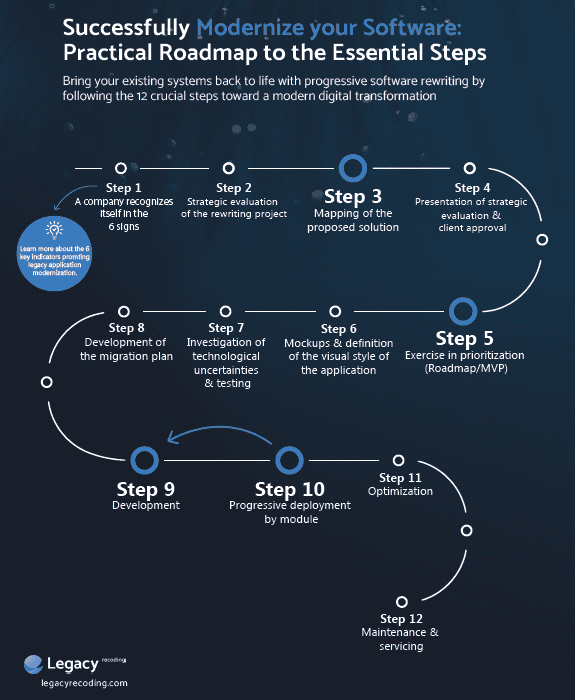Modernization roadmap guide
Download our free checklist and make sure you don’t miss anything during the modernization stages of your application.

Modernizing software applications has become essential for companies wishing to remain competitive and meet the ever-changing needs of their users. However, this complex process can be daunting if not carefully planned and precisely executed. We’ve developed a 12-step modernization roadmap to help you successfully transform your software applications.
In this article, we explore the key elements of each stage to better understand their importance and contribution to the overall success of a modernization project. From identifying the signs indicating the need for modernization to prioritizing actions in a roadmap, each step plays a crucial role in the process, enabling you to migrate your data to a modernized, future-proof application.

Download our free checklist and make sure you don’t miss anything during the modernization stages of your application.


Learn to spot when your application needs modernizing by recognizing key signs such as performance issues, compatibility problems, security risks, critical dependencies and obstacles posed by technological evolution.
Identifying these signs is the first step towards modernizing your application, an essential process for increasing your operational efficiency and staying competitive in a rapidly changing technological landscape.

Assessing the strategic aspects of the rewrite project involves an in-depth technical analysis of the existing application, as well as an evaluation of the company’s various processes. This may include an audit of existing code and documentation. It is also crucial to draw up a project vision statement to clearly define the objectives to be achieved and ensure that the direction taken is the right one.
Key elements to consider include: an in-depth analysis of the current code to identify weak points and opportunities for improvement, an economic and strategic justification for the project, identification and mapping of the application’s current processes, profiling of the application’s key users, a diagram of interactions between the various existing systems, as well as a table of technological assumptions, prerequisites, dependencies and uncertainties with their levels of risk, etc.
This approach is crucial for :

Defining the envisaged solution involves identifying the key processes, their functionalities and the connections between modules, in order to establish an optimized project map. This also enables us to discuss with stakeholders the business rules specific to each company, and to propose optimizations based on knowledge of the business domain.
This step ensures a comprehensive and structured approach to modernization.

After presenting and handing over the final deliverable from steps 2 and 3 to the customer, it’s crucial to obtain their approval and commitment. This step ensures transparency, aligns expectations, and reinforces mutual understanding and willingness to pursue planned initiatives. Once you receive the green light for the project, you can proceed with step 5.

Step 5 involves a collaborative exercise with the company’s stakeholders and the technology partner’s development team (Product Owner, Scrum Master, and Developers).
In this exercise, the customer prioritizes functionalities on a horizontal axis with four priority columns: P1, P2, P3, P4. The development team then positions these functionalities on a vertical axis based on complexity, from most complex to least complex within each column.
This process is essential to:

Prototyping and styling of the application involves the creation of mock-ups (wireframe or high-fidelity, depending on project requirements) to validate the visual design (UI) and user experience (UX).
This process focuses on essential modules and core functionalities, ensuring that they meet user expectations and respect the usability standards expected by the customer.
Modernizing a software application is a complex process, but by following these 12 crucial steps, companies can successfully modernize their applications and ensure their longevity for years to come. With careful planning, precise execution, and continuous engagement, application modernization can become a successful digital transformation opportunity for any company.
To assist you in your application modernization project, we have created a practical checklist. This document guides you through each step of the process, providing helpful tips and checkpoints to ensure your project’s success.

Exploring technological uncertainties involves an in-depth investigation of risks, often accompanied by proofs of concept to confirm or refute certain hypotheses before the project is even launched. This proactive approach aims to identify and resolve potential obstacles preventively, before developing or planning risk reduction strategies.
It ensures smoother project progress and successful outcomes by tackling problems at an early stage.

The development of the migration plan is crucial to ensuring the integrity and quality of migrated data.
Rigorous monitoring of data quality must be maintained throughout both the development and infrastructure phases. The process begins with a thorough assessment of the current state of the data. Next, an automated migration system is implemented to enable progressive, proactive validation of historical data quality. This approach ensures that data integrity is preserved and that the new system runs smoothly from launch.

In the development phase, the team adopts an agile approach with iterative sprints to transform business needs into a functional application. It begins with a sprint 0, where epics are defined, user stories refined, and the project architecture established. Each subsequent sprint enables the team to implement the planned visual style and functional requirements of the old application.
The process includes rigorous testing to quickly identify and resolve potential issues and iterative improvements based on feedback and test results. Close collaboration with stakeholders ensures the final product meets customer constraints and expectations, following development best practices for efficient, quality delivery.

As part of software modernization, the progressive deployment of modules plays an essential role. This approach involves the gradual development and deployment of application modules in the form of microservices, using an iterative methodology to reduce risk, obtain continuous feedback and maximize efficiency.
Gradual deployment minimizes disruption to current operations and gradually increases user adoption. This method facilitates the early identification and resolution of problems, reducing the risk of data disruption and avoiding the challenges associated with massive “Big Bang” deployments. As a result, the old application is gradually decommissioned once the new modules are fully operational. This approach guarantees a smooth transition without data loss or disruption.

The optimization phase focuses on the continuous improvement of new modules in response to user feedback and customer requests. The aim is to increase functionality, improve performance and enhance user satisfaction over time. This approach is essential to avoid having to repeat a complete modernization every 10 years, ensuring that the system remains adapted and efficient in the face of technological developments and the changing needs of users and businesses.

Ongoing maintenance and the correction of operational bugs are essential to ensure the smooth running of the new application. This phase includes proactive security monitoring, regular updates, and technical debt management to keep the application up to date and prevent future problems.
It’s also crucial to monitor system performance, provide user support, and make any necessary adjustments to meet changing business needs and technological advances.
This guarantees the longevity and optimal performance of the application, ensuring its ability to continually meet domain and business requirements.
Subscribe to receive our exclusive updates directly to your email.

Modernizing a software application is a complex process that requires a methodical, well-planned approach. By carefully following the 12 essential steps we’ve detailed, companies can successfully modernize their applications while ensuring longevity for years to come. These steps, from recognizing the need for modernization to ongoing maintenance and operations, are designed to keep the application fit for purpose, secure, and efficient over time.
With rigorous planning, precise execution, and a commitment to continuous improvement, application modernization becomes a strategic opportunity to drive innovation and support business growth in an ever-changing digital environment. To support you in your application modernization project, our practical checklist guides you through every step of the process, ensuring the lasting success of your initiative.
Tell us more about your needs so that we can better route your project to our specific SWAT team.
1
During the brainstorming phase, we work with you to identify potential solutions to your business challenges to generate the technology response that aligns with your business objectives.
2
Through our requirements gathering process, we work closely with you to define and prioritize your needs, ensuring that our solutions are tailored to meet your specific requirements.
3
This phase marks the beginning of our partnership. We’ll finalize the project plan and establish clear communication channels to ensure a smooth and successful project execution.